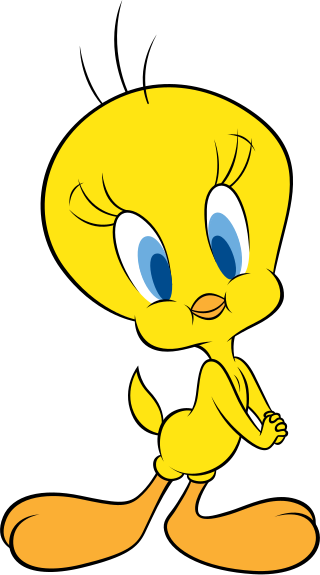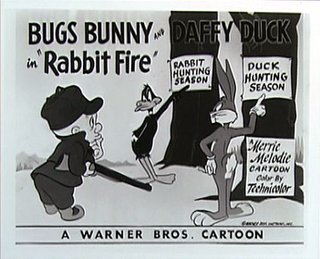
Looney Tunes is an American animated franchise produced and distributed by Warner Bros. It began as a series of short films that originally ran from 1930 to 1969, concurrently with its partner series Merrie Melodies, during the golden age of American animation. Following a revival in the late 1970s, new shorts were released as recently as 2014. The two series introduced a large cast of characters, including Bugs Bunny, Daffy Duck, and Porky Pig. The term Looney Tunes has since been expanded to also refer to the characters themselves.

Daffy Duck is a fictional character created by animators Tex Avery and Bob Clampett for Leon Schlesinger Productions. Styled as an anthropomorphic black duck, he has appeared in cartoon series such as Looney Tunes and Merrie Melodies, in which he is usually depicted as a foil for either Bugs Bunny, Porky Pig or Speedy Gonzales. He was one of the first of the new "screwball" characters that emerged in the late 1930s to replace traditional everyman characters who were more popular earlier in the decade, such as Mickey Mouse, Porky Pig, and Popeye.

Porky Pig is an animated character in the Warner Bros. Looney Tunes and Merrie Melodies series of cartoons. He was the first character created by the studio to draw audiences based on his star power, and the animators created many critically acclaimed shorts featuring the character. Even after he was supplanted by later characters, Porky continued to be popular with moviegoers and, more importantly, the Warners directors, who recast him in numerous everyman and sidekick roles.

Tweety is a yellow canary in the Warner Bros. Looney Tunes and Merrie Melodies series of animated cartoons. The name "Tweety" is a play on words, as it originally meant "sweetie", along with "tweet" being an English onomatopoeia for the sounds of birds. His characteristics are based on Red Skelton's famous "Junior the Mean Widdle Kid." He appeared in 46 cartoons during the golden age, made between 1942 and 1964.

Speedy Gonzales is an animated cartoon character in the Warner Bros. Looney Tunes and Merrie Melodies series of cartoons. He is portrayed as "The Fastest Mouse in all Mexico" with his major traits being the ability to run extremely fast, being quick-witted and heroic while speaking with an exaggerated Mexican accent. He usually wears a yellow sombrero, white shirt and trousers, and a red kerchief, similar to that of some traditional Mexican attires. To date, there have been 46 theatrical shorts made either starring or featuring the character.

Sylvester J. Pussycat Sr. is a fictional character, an anthropomorphic cat in the Looney Tunes and Merrie Melodies series of cartoons. Most of his appearances have him often chasing Tweety Bird, Speedy Gonzales, or Hippety Hopper. He appeared in 103 cartoons in the golden age of American animation, lagging only behind superstars Bugs Bunny, Porky Pig, and Daffy Duck. Three of his cartoons won Academy Awards, the most for any starring a Looney Tunes character: they are Tweetie Pie, Speedy Gonzales, and Birds Anonymous.

Yosemite Sam is a cartoon character in the Looney Tunes and Merrie Melodies series of short films produced by Warner Bros. His name is taken from Yosemite National Park in California. He is an adversary of Bugs Bunny and his archenemy alongside Elmer Fudd. He is commonly depicted as a mean-spirited and extremely aggressive, gunslinging outlaw or cowboy with a hair-trigger temper and an intense hatred of rabbits, Bugs in particular. In cartoons with non-Western themes, he uses various aliases, including "Chilkoot Sam" and "Square-deal Sam" in 14 Carrot Rabbit, "Riff Raff Sam" in Sahara Hare, "Sam Schultz" in Big House Bunny, "Seagoin' Sam" in Buccaneer Bunny, "Shanghai Sam" in Mutiny on the Bunny, "Von Schamm the Hessian" in Bunker Hill Bunny, "Baron Sam von Schpamm" in Dumb Patrol, and many others. During the golden age of American animation, Yosemite Sam appeared as antagonist in 33 animated shorts made between 1945 and 1964.

Granny is a fictional character created by Friz Freleng, best known from the Looney Tunes and Merrie Melodies animated short films of the 1950s and 1960s. She is the owner of Tweety Bird and, more often than not, Sylvester and Hector. Her voice was first provided by Bea Benaderet from 1950 through 1955, then by June Foray for almost 60 years then Candi Milo took over in 2017 following Foray’s death.

Falling Hare is a 1943 Warner Bros. Merrie Melodies cartoon directed by Bob Clampett. The cartoon features Bugs Bunny.

Rabbit Fire is a 1951 Looney Tunes cartoon starring Bugs Bunny, Daffy Duck, and Elmer Fudd. Directed by Chuck Jones and written by Michael Maltese, the cartoon is the first in Jones' "hunting trilogy"—the other two cartoons following it being Rabbit Seasoning and Duck! Rabbit, Duck! It is also the first cartoon to feature a feud between Bugs and Daffy. Produced by Edward Selzer for Warner Bros. Cartoons, Inc., the short was released to theaters on May 19, 1951 by Warner Bros. Pictures and is often considered among Jones' best and most important films.

Daffy Duck's Quackbusters is a 1988 animated compilation film featuring classic Warner Bros. Cartoons shorts and animated bridging sequences, starring Daffy Duck. The film was released to theaters by Warner Bros. on September 24, 1988. It was the final theatrical production in which Mel Blanc provided the voices of the various Looney Tunes characters before his death in July 1989.
Robert Cameron Bruce Jr. was an American voice actor and the son of Robert Cameron Bruce (1887–1948) who was a cinematographer and documentary producer. He was the narrator for a number of Warner Bros. cartoons in the 1930s and 1940s. The Looney Tunes and Merrie Melodies series' had occasional entries which were driven not by one of their stable of stars such as Bugs Bunny or Daffy Duck, but by individual short sketches, usually filled with sight gags and word-play. Later he was a writer and producer of industrial motion pictures based in Minnesota.

Bah, Humduck! A Looney Tunes Christmas is a 2006 animated direct-to-DVD Christmas comedy film starring the Looney Tunes characters, directed by Charles Visser, produced by Warner Bros. Animation and animated by Toon City Animation. The film is based on Charles Dickens' classic novella A Christmas Carol (1843). The special was released on DVD on November 14, 2006, and was then broadcast on Cartoon Network in December 2006. The special was rereleased on DVD as part of the Looney Tunes Holiday Triple Feature on September 1, 2020.
Ain't That Ducky is a 1945 Warner Bros. Looney Tunes cartoon, directed by Friz Freleng. The cartoon was released on May 19, 1945, and stars Daffy Duck.

Apes of Wrath is a 1959 Warner Bros. Merrie Melodies animated short directed by Friz Freleng. The short was released on April 18, 1959, and stars Bugs Bunny. This cartoon recycles the plot from the 1948 cartoon Gorilla My Dreams. The title is a parody of John Steinbeck's novel The Grapes of Wrath.
Along Came Daffy is a 1947 Warner Bros. Looney Tunes cartoon directed by Friz Freleng and written by Michael Maltese and Tedd Pierce. The cartoon was released on June 14, 1947, and stars Daffy Duck and Yosemite Sam.
Hobo Bobo is a 1947 Warner Bros. Merrie Melodies cartoon short directed by Robert McKimson. The short was released on May 17, 1947.
Dime to Retire is a 1955 Warner Bros. Looney Tunes cartoon directed by Robert McKimson. The cartoon was released on September 3, 1955, and stars Daffy Duck and Porky Pig.













